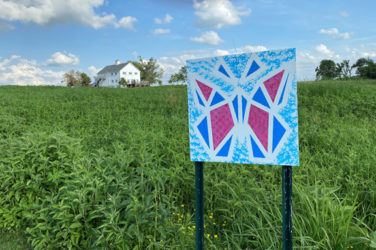Written by Eric Jones
Photos by Duane Tinkey and Dana Miller
Full disclosure: Hotels almost always depress me a little. There’s something sad about long hallways where every door is locked, something unnerving about how quiet a building filled with strangers can be. I’d make a terrible business traveler.
Anyway, that’s the personal baggage I brought along on visits to two recently opened and highly original hotels in Iowa: the Historic Park Inn in Mason City, the only Frank Lloyd Wright-designed hotel left in the world, and The Hotel at Kirkwood Center in Cedar Rapids, one of the most cutting-edge teaching hotels anywhere. They both earn my highest praise—neither made me the least bit depressed.
The Historic Park Inn is something old made new again, a 102-year-old landmark saved from roosting pigeons and the wrecking ball by a group of Mason City volunteers at a cost of around $18 million. Back in 1908, two local lawyers hired the already-famous Wright to design a multi-use building that would house their law offices and, to provide rental income, a bank and a hotel. Construction on the building began in April 1909. In October of that year, Wright, married with six children, scandalized America by running off to Europe with Martha “Mamah” Borthwick Cheney, the Boone, Iowa-born wife of one of Wright’s clients and herself a mother of two. A colleague of Wright’s had to oversee completion of the building, and it opened to what seems little fanfare in August 1910.
Wright’s building makes quite an impression. Just three stories tall, it stretches close to an entire city block and looks like nothing else you’ve seen on an Iowa town square. It has a striking Roman brick facade the color of beach sand (Roman brick is to regular brick what a stretch limo is to a Lincoln Town Car—much longer); terra-cotta accents of geometric shapes in green, red and pastel blue; dramatically wide overhanging eaves; a series of staggered horizontal rooflines; and long rows of windows. The building is a classic example of the Prairie School style that Wright helped create.
“You couldn’t imagine what poor shape the building was in,” says Ann MacGregor, executive director of Wright on the Park Inc., the nonprofit group that raised all that money (it got a big boost from a $9 million Vision Iowa grant in 2008) and oversaw the restoration. The hotel had been shuttered since the 1970s. The whole building had fallen victim to a series of remodels that cloaked Wright’s design in the bland business-casual of Main Street America—a series of plate-glass-windowed storefronts. By the time Wright on the Park began its work, the once-grand edifice was an eyesore not obviously worth saving. The roof leaked badly, there was standing water in the basement, and pigeons nested in third-floor hotel rooms. “It was a city embarrassment,” MacGregor says.
Bergland and Cram Architects Inc. of Mason City, which oversaw the building’s restoration, was able to get Wright’s blueprints. But the architectural drawings of that time weren’t as detailed as they are today, and there was scant photographic evidence of what the building’s interiors looked like. So a big volunteer crew of local residents, including Wright fans, retirees and one-time construction contractors, painstakingly dismantled those interiors to figure out what they looked like 100 years ago. “It was almost like an archaeological dig,” said Randall Cram, president of Bergland and Cram. “When we got down to the last layer, we knew were at the original.”
All that effort yielded lots of discoveries, including paint colors, a distinctive fan pattern on the plaster walls (reproduced now throughout the building) and even three intact stained-glass skylights that had been overlaid with a ceiling.
In adherence to National Park Service and State Historical Society of Iowa guidelines regarding historic preservation, anything in the building that was original and in salvageable condition had to stay. That’s why the brick-colored ceramic tile floor in the lobby is far from perfect. Some broken tiles were replaced, but for the most part, you’ll see the original floor as Wright envisioned it, only with a century of quite visible wear. In the midst of the hotel’s splendor—every detail now seems utterly perfect—the old lobby floor offers a kind of comfort, a reminder that time invariably leaves its mark.
Though the thoroughly contemporary Hotel at Kirkwood Center features striking design—brushed steel and polished surfaces, plus floor-to-ceiling windows in almost every public area, hallway and guest room–the really distinctive feature of the building isn’t how it looks, but what happens there.
This hotel is home to Kirkwood Community College’s hospitality arts program, with more than 300 students in focus areas that include hotel management, restaurant management and culinary arts. Think of The Hotel at Kirkwood Center not as a brand-new, $24 million, AAA four-diamond-rated hotel (which, of course, it is), but as a 117,000-square-foot, 71-guest-room laboratory, where students preparing for careers in hotels, resorts and restaurants get an unbeatable learning opportunity—trial by guest.
With customers dining in the hotel’s gourmet restaurant, The Class Act, and sleeping in its oh-so-plush beds, students have the chance to try what they’ve learned in the classroom (and in state-of-the-art kitchen and baking laboratories) on real-world travelers.
Seeing the complex’s spotless, video-monitor-equipped kitchen and baking labs was enough to make me, an amateur cook at best, want to buy a white coat and a pair of those funny rubber chefs’ shoes and go back to school. The cooking lab has eight commercial stoves (two students share each stove in a class of 16) and an instructor who leads the group through as many as 12 recipes in a four-hour session. A camera trained on the instructor’s prep station allows students to follow even the subtlest knife work on flat-screen monitors.
In addition to learning “Stocks and Sauces” or “Hospitality Accounting” on a block plan (classes move sequentially, one at a time, from, say, basic kitchen safety to advanced techniques for storing salads, cheeses and terrines at ideal temperatures), students work alongside the professional chefs, hotel managers and desk clerks who staff the hotel. As a result, they all benefit. Students get real-life exposure and hands-on instruction, while hotel employees (called mentors in their role as teachers) get a satisfying chance to guide hundreds of young people toward careers as hospitality professionals.
It makes perfect sense that the art on the walls here is largely by Kirkwood students, alumni and faculty. A school is first and foremost a community. And if there are artists in your community, why wouldn’t you ask them to add beauty to a new space? Competition-winning student photographs hang in guest rooms and along a corridor that runs past the kitchen and baking labs. Associate professor of art Conifer Smith and her pupils show a number of their pieces in the hotel, including an intricate chandelier in the restaurant. It’s composed of dozens of clear glass globes surrounding a larger globe of white-painted glass, like see-through planets circling a shimmering star.
“Even in very high-end hotels, the art looks like it was purchased at a factory,” says Arbe Bareis, coordinator of Kirkwood’s fine and performing arts programs. To avoid that assembly-line aesthetic, Bareis selected, commissioned and purchased the pieces that fill the hotel. “When it comes to the sheer amount of original art collected for this place, The Hotel at Kirkwood Center might be unique in the country,” he says.
It’s easy, as a visitor here, to pick up on the students’ ambitions, their desire to serve their customers well and make them happy. This sense of extra effort adds an interesting layer to what could otherwise be a mundane exchange between guest and employee. While staying at the hotel, I had the subtle but unmistakable feeling that something important was happening even in the simplest exchanges—a feeling that, all around me, young people were trying and mastering the age-old skills of hostelry.
A richness and depth of relationship—to people, to the past, to the future and to Iowa—distinguishes both these new hotels from the many chains that fringe our freeway exits. If the typical hotel isolates us, makes us feel as though we could be anywhere or nowhere, these two connect us—to particular places and memorable people.
Thinking back to my stay at Wright’s Historic Park Inn, I recall two experiences I won’t forget. First: The ceiling over the front desk in the hotel lobby was so low I worried about hitting my head. Then I took in that space’s gleaming dark wood trim, Craftsman-style furniture and attractive lighting. Everything felt intimate, comfortable, safe. I hesitate to believe that architecture can change us, that something as public as a hotel lobby can help us in our attempts to be the kinds of people we want to be. But at that moment I recognized it as a possibility.
Second: Down in the Park Inn’s basement, there’s a bar small enough that if you go there to have a drink alone, you’ll be doing it very close to someone else. In the short time I sat there, three different strangers struck up conversations with me, not because I’m overly friendly, but because they assumed we shared an interest either in history, or in architecture, or in Frank Lloyd Wright.
One man, a retired insurance executive, said something funny about his son. For some reason, I don’t remember why, I asked him what I might be missing by not having kids. Then, in the following conversation, he told me his second son was killed by a sniper’s bullet three years ago in Afghanistan. “You don’t get over that,” he said. I didn’t know what to say except that I was sorry. When he stood up to go to bed, I stood up, too, so I could shake his hand. But instead, he gave me a hug.
A graduate of the University of Iowa’s nonfiction writing program, Eric Jones has worked as a household mover for the last decade. He’s moved hundreds of families away from Iowa to places as far flung as Eastport, Maine, and Anchorage, Alaska. Then, he says, he’s moved a surprising number of those same families back. He lives in Iowa City.
The Skylight Room, behind the Historic Park Inn’s lobby, takes its name from Wright’s glass ceiling panels. These are accented with bits of bright green and framed in beams of Douglas fir. The room’s rolled-arm leather sofa, Craftsman-style tables and grouping of art pottery evoke the early 1900s.
Though the Hotel at Kirkwood Center’s lobby sits close to the ground, two walls of translucently curtained windows lend it the soaring, sophisticated air of a big-city penthouse lounge. Not surprisingly, the room has become locally favored for receptions. Alongside this lobby are a boardroom seating 12 and a conference room sized for up to 24 guests.
Rising from the edge of its sponsoring college’s campus, the Kirkwood contains 71 guest rooms.
Every spring, hospitality students learn front-desk operations at the Kirkwood.
Today’s competitive restaurant scene requires young cooks to master the art of immaculate plating.
What appears as kitchen pandemonium at the Kirkwood is actually skillfully choreographed.
Tables in the Kirkwood’s Presidential Suite showcase artisan-made glass.
The Historic Park Inn survives as a textbook example of Frank Lloyd Wright architecture. He specified the flat, deep overhang, embedded square columns, geometric ornamentation and leaded glass. Twin Wright-designed lampposts signal the entrance to a space the hotel’s developers once rented to City National Bank. Now that former banking hall is the hotel’s ballroom.
The Hotel at Kirkwood Center’s kitchen demands concentration and lightning-fast responses from its student cooks. Beginning with basic classes in safety and sauce-making, these novices absorb a wide range of food-preparation techniques. Cameras trained on their instructors allow students to follow directions on flatscreen monitors.
A sepia-toned postcard depicts the Park Inn during the 1920s.
This same facade retains its original, locally made sand-colored bricks.
A third-floor premier room at the Historic Park Inn presents guests with views of Mason City in three directions.
The Historic Park Inn’s new restaurant, the 1910 Grille, prepares contemporary dishes including its often-requested Prairie Mushroom Risotto.
Beneath the Historic Park Inn’s lobby, the 1910 Lounge serves as a convivial spot for a nightcap. Its metal-edged ceiling lights and block-patterned carpet pay homage to Wright’s signature style. Bergland and Cram Architects Inc., a Mason City firm, oversaw the hotel’s renovation.
At the Hotel at Kirkwood Center, a row of weather-resistant armchairs is cooled by dashing, sail-like red sun screens on the patio. This open space adjoins The Class Act, an in-house restaurant. OPN Architects Inc. in Cedar Rapids designed the hotel structure. Guest rooms were completed with advice from Kuhlmann Design Group, Inc., in St. Louis.




















